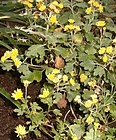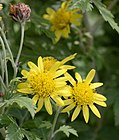Note: This is a project under development. The articles on this wiki are just being initiated and broadly incomplete. You can Help creating new pages.
Difference between revisions of "Chrysanthemum indicum"
| Line 1: | Line 1: | ||
[[File:Chrysanthemum indicum jd plt fl.jpg|thumb|right]] | [[File:Chrysanthemum indicum jd plt fl.jpg|thumb|right]] | ||
| + | '''Chrysanthemum indicum''' is an erect, aromatic, perennial plant producing a clump of stems 25 - 100cm tall from procumbent rhizomes. The plant is harvested from the wild for local use as a food and medicine. It is sometimes cultivated for medicinal use. | ||
==Uses== | ==Uses== | ||
| − | {{Uses|}}, {{Uses|}}, {{Uses|}}, {{Uses|}}, {{Uses|}}, {{Uses|}}, {{Uses| | + | {{Uses|Furuncle}}, {{Uses|Scrofula}}, {{Uses|Deep-rooted boils}}, {{Uses|Inflammation of the throat}}, {{Uses|Eczema}}, {{Uses|Itchiness of the skin}}, {{Uses|Hypertension}}. |
==Parts Used== | ==Parts Used== | ||
| − | {{Parts Used|}}, {{Parts Used| | + | {{Parts Used|Flower heads}}, {{Parts Used|Young leaves}}. |
==Chemical Composition== | ==Chemical Composition== | ||
| Line 16: | Line 17: | ||
===Dravya=== | ===Dravya=== | ||
===Rasa=== | ===Rasa=== | ||
| − | |||
===Guna=== | ===Guna=== | ||
| Line 29: | Line 29: | ||
==Habit== | ==Habit== | ||
| − | {{Habit|}} | + | {{Habit|Perennial}} |
==Identification== | ==Identification== | ||
| Line 48: | Line 48: | ||
==Mode of Propagation== | ==Mode of Propagation== | ||
| − | {{Propagation|}} | + | {{Propagation|Seeds}} |
==How to plant/cultivate== | ==How to plant/cultivate== | ||
| − | <ref name="How to plant/cultivate"/> | + | Chrysanthemum indicum is a plant of the temperate zone and a parent of the cultivated Chrysanthemums. Although temperate in origin, it can be grown successfully in tropical areas and is often cultivated in southeast Asia.<ref name="How to plant/cultivate"/> |
==Commonly seen growing in areas== | ==Commonly seen growing in areas== | ||
| − | {{Commonly seen|}}, {{Commonly seen|}}, {{Commonly seen|}}, {{Commonly seen|}}, {{Commonly seen|}}. | + | {{Commonly seen|Grasslands on mountain slopes}}, {{Commonly seen|Thickets}}, {{Commonly seen|Wet places by rivers}}, {{Commonly seen|Fields}}, {{Commonly seen|Roadsides}}. |
==Photo Gallery== | ==Photo Gallery== | ||
| Line 71: | Line 71: | ||
<ref name="Leaf">["Morphology"]</ref> | <ref name="Leaf">["Morphology"]</ref> | ||
| − | <ref name="How to plant/cultivate">[ | + | <ref name="How to plant/cultivate">[http://tropical.theferns.info/viewtropical.php?id=Chrysanthemum+indicum Cultivation]</ref> |
| − | + | ||
</references> | </references> | ||
Revision as of 14:56, 15 April 2020
Chrysanthemum indicum is an erect, aromatic, perennial plant producing a clump of stems 25 - 100cm tall from procumbent rhizomes. The plant is harvested from the wild for local use as a food and medicine. It is sometimes cultivated for medicinal use.
Contents
- 1 Uses
- 2 Parts Used
- 3 Chemical Composition
- 4 Common names
- 5 Properties
- 6 Habit
- 7 Identification
- 8 List of Ayurvedic medicine in which the herb is used
- 9 Where to get the saplings
- 10 Mode of Propagation
- 11 How to plant/cultivate
- 12 Commonly seen growing in areas
- 13 Photo Gallery
- 14 References
- 15 External Links
Uses
Furuncle, Scrofula, Deep-rooted boils, Inflammation of the throat, Eczema, Itchiness of the skin, Hypertension.
Parts Used
Chemical Composition
Common names
| Language | Common name |
|---|---|
| Kannada | |
| Hindi | |
| Malayalam | |
| Tamil | |
| Telugu | |
| Marathi | |
| Gujarathi | |
| Punjabi | |
| Kashmiri | |
| Sanskrit | |
| English |
Properties
Reference: Dravya - Substance, Rasa - Taste, Guna - Qualities, Veerya - Potency, Vipaka - Post-digesion effect, Karma - Pharmacological activity, Prabhava - Therepeutics.
Dravya
Rasa
Guna
Veerya
Vipaka
Karma
Prabhava
Habit
Identification
Leaf
| Kind | Shape | Feature |
|---|---|---|
Flower
| Type | Size | Color and composition | Stamen | More information |
|---|---|---|---|---|
| {{{5}}} |
Fruit
| Type | Size | Mass | Appearance | Seeds | More information |
|---|---|---|---|---|---|
Other features
List of Ayurvedic medicine in which the herb is used
Where to get the saplings
Mode of Propagation
How to plant/cultivate
Chrysanthemum indicum is a plant of the temperate zone and a parent of the cultivated Chrysanthemums. Although temperate in origin, it can be grown successfully in tropical areas and is often cultivated in southeast Asia.[3]
Commonly seen growing in areas
Grasslands on mountain slopes, Thickets, Wet places by rivers, Fields, Roadsides.
Photo Gallery
References
- ↑ ["Chemistry"]
- ↑ ["Morphology"]
- ↑ Cultivation
External Links
- [ ]
- [ ]
- [ ]
- Ayurvedic Herbs known to be helpful to treat Furuncle
- Ayurvedic Herbs known to be helpful to treat Scrofula
- Ayurvedic Herbs known to be helpful to treat Deep-rooted boils
- Ayurvedic Herbs known to be helpful to treat Inflammation of the throat
- Ayurvedic Herbs known to be helpful to treat Eczema
- Ayurvedic Herbs known to be helpful to treat Itchiness of the skin
- Ayurvedic Herbs known to be helpful to treat Hypertension
- Herbs with Flower heads used in medicine
- Herbs with Young leaves used in medicine
- Habit - Perennial
- Index of Plants which can be propagated by Seeds
- Herbs that are commonly seen in the region of Grasslands on mountain slopes
- Herbs that are commonly seen in the region of Thickets
- Herbs that are commonly seen in the region of Wet places by rivers
- Herbs that are commonly seen in the region of Fields
- Herbs that are commonly seen in the region of Roadsides
- Herbs
- Pages without herbs images




